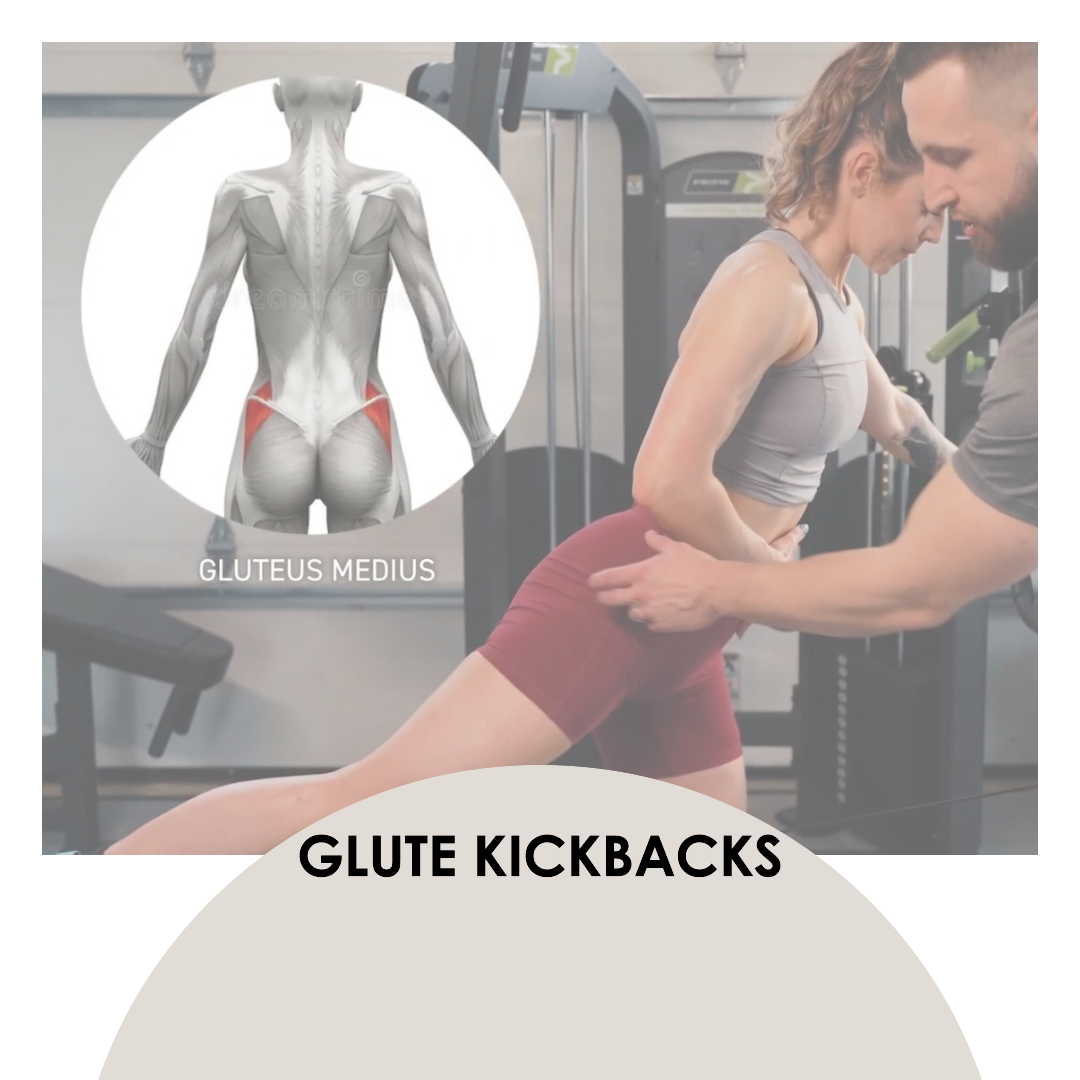Ultimate Guide to Glute Kickbacks: Techniques and Benefits10 min read
Glute kickbacks are a highly effective exercise for targeting and strengthening the gluteal muscles, specifically the gluteus maximus. As one of the most powerful muscle groups in our lower body, building stronger glutes can improve overall lower body strength and minimize injury risks. In this blog post, we will examine the mechanics and advantages of various glute kickback exercises to maximize their effectiveness in your workout routine.
We’ll explore cable machine glute kickbacks, resistance band variations, dedicated glute kickback machines, and exercises focusing on the often-neglected gluteus medius. By understanding these techniques’ intricacies and benefits, you’ll be better equipped to incorporate them into your fitness regimen effectively.
Table of Contents:
- Strengthen Your Glutes with Cable Glute Kickbacks
- How to Perform Cable Glute Kickbacks
- How to Do Glute Kickbacks with a Band
- Glute Kickbacks Machine: What You Need to Know
- Mastering Glute Medius Kickbacks
- Glute Kickbacks: An Effective Exercise for Building Stronger Glutes
- How to Perform Glute Kickbacks
- Other Glute Exercises
- Conclusion
1. Strengthen Your Glutes with Cable Glute Kickbacks
If you’re looking to target and strengthen your glutes for improved performance and aesthetics, cable glute kickbacks are an excellent exercise to add to your workout routine. Targeting all three gluteal muscles, the gluteus maximus, medius and minimus is what makes cable glute kickbacks an effective exercise for glute activation and strengthening your posterior.
How to Perform Cable Glute Kickbacks
- Set up: Attach a cuff or ankle strap to a low pulley cable machine. Stand facing the machine with one foot in the cuff or strap and hold onto the handles for support.
- Maintain proper form: Keep your core engaged and maintain a slight bend in your standing leg’s knee throughout the movement. This will help protect your lower back from strain.
- Kickback motion: Slowly extend your cuffed leg behind you while keeping it straight but not locked at the knee joint. Squeeze your glutes at full extension before returning to the starting position.
- Variations: To increase difficulty or change muscle emphasis, try performing this exercise on one leg without holding onto any support (free-standing), adding pauses at peak contraction, or changing foot positioning (e.g., pointing toes outward).
Cable machines offer constant tension throughout each rep of this isolation exercise – ensuring maximum engagement of targeted muscles (source). Additionally, they allow for precise control over resistance levels so that users can easily progress as their strength increases.
Tips for Success with Cable Glute Kickbacks
- Warm up properly before starting your workout to reduce the risk of injury. A dynamic warm-up, such as leg swings or hip circles, can help activate and prepare the glutes for exercise.
- Choose a weight that allows you to perform each rep with proper form but still challenges your muscles. If having trouble with stability or discomfort in the lower back, try decreasing the weight until it’s more manageable.
- Incorporate cable glute kickbacks into a well-rounded fitness routine that includes other compound exercises like squats and deadlifts for optimal results.
FitnessMind.org offers comprehensive information on various health and fitness topics – including detailed guides on how to effectively strengthen your glutes through targeted exercises like cable kickbacks. By incorporating these movements into your regular workouts, you’ll be well on your way toward achieving stronger, more sculpted buttocks.
Key Takeaway:
Cable glute kickbacks are an effective exercise to target and strengthen the entire gluteal muscle group. Proper form, warm-up, weight selection, and incorporating this exercise into a well-rounded fitness routine with compound exercises like squats and deadlifts can lead to optimal results in achieving stronger and more sculpted buttocks.
How to Do Glute Kickbacks with a Band
If you’re looking for an effective lower body workout that targets the glutes and other muscles in the legs, glute kickbacks with a band are an excellent choice for powerful muscles. This workout can be done with ease in either a home or gym setting, requiring minimal gear.
Choosing the Right Resistance Band
The first step in performing banded glute kickbacks is selecting the appropriate resistance band. There are various types of bands available on the market, including looped bands and tube bands with handles. Choose one that provides enough resistance to challenge your muscles without causing strain or discomfort.
Setting Up for Banded Glute Kickbacks
- Anchoring your band: Securely anchor your resistance band around a sturdy post or piece of furniture close to ankle height. If using a looped band, simply wrap it around both ankles; if using a tube band with handles, attach one handle to your working ankle while keeping tension on the other end.
- Finding proper alignment: Stand facing towards your anchor point with feet hip-width apart and maintain good posture by engaging your core muscles throughout this exercise.
- Gripping support: Hold onto something stable like a wall or chair for balance during this movement if needed.
Performing Banded Glute Kickbacks: Step-by-Step Guide
- Lift one foot off the ground while maintaining stability through engagement of core muscles and supporting leg.
- Slowly kick the lifted leg back and up, focusing on squeezing your glutes at the top of the movement. Ensure that you maintain a neutral spine throughout this exercise to avoid lower back strain.
- Hold for a brief moment before slowly returning your foot to its starting position.
- Repeat for desired number of repetitions (typically between 10-15) before switching legs.
Banded glute kickbacks are an excellent addition to any lower body workout routine. By incorporating them into your regular fitness regimen, you can effectively target and strengthen the muscles in your glutes and legs while also improving overall stability and balance. For more variations of this exercise or other ways to challenge yourself, check out these resistance band butt workouts.
Key Takeaway:
Glute kickbacks with a band are an effective lower body workout that targets the glutes and other muscles in the legs. To perform this exercise, choose an appropriate resistance band, anchor it securely around ankle height, maintain proper alignment and engage your core muscles throughout the movement. By incorporating banded glute kickbacks into your regular fitness routine, you can strengthen your glutes and legs while improving overall stability and balance.
4. Glute Kickbacks Machine: What You Need to Know
If you’re looking for an effective way to target your glutes and other muscles in the legs, a glute kickback machine might be just what you need. This piece of equipment is designed specifically for performing glute kickbacks, allowing you to isolate and strengthen these important muscles.
To get started with using a glute kickback machine, follow these simple steps:
- Adjust the machine: Before starting your workout, make sure that the machine is adjusted correctly according to your height and leg length. Most machines have adjustable settings for both the footplate and back pad.
- Select appropriate weight: Choose a weight that allows you to perform at least 8-12 repetitions per set while maintaining proper form. If you’re new to this exercise or haven’t used a glute kickback machine before, start with lighter weights until you become more comfortable with the movement.
- Maintain proper form: When performing glute kickbacks on a machine, it’s essential that you maintain correct posture throughout each repetition. Keep your core engaged, spine neutral, and avoid arching your lower back as much as possible during the exercise.
In addition to providing an effective workout targeting your glutes directly, using a dedicated piece of equipment like this can offer several benefits over alternative methods, such as cable or banded variations of the exercise:
- Better isolation: The design of most machines helps ensure that only targeted muscle groups are activated during each rep, which can lead to more efficient muscle growth.
- Improved stability: Machines provide a stable base for performing the exercise, reducing the risk of injury and allowing you to focus on proper form and technique.
- Easier progression: With weight stacks or plates readily available, it’s simple to increase resistance as your strength improves over time. This makes tracking progress easier compared with other methods that may require purchasing additional bands or finding creative ways to add resistance.
However, it’s important not to rely solely on machines for your glute training. Incorporating a variety of exercises targeting different muscles in the lower body will help ensure balanced development and prevent potential imbalances that could lead to injury. Some great complementary exercises include squats, lunges, and deadlift variations.
In summary, using a glute kickback machine can be an effective way to target your glutes while providing several benefits over alternative methods like cables or bands. However, make sure you also incorporate other lower-body exercises into your routine for well-rounded results.
Key Takeaway:
A glute kickback machine is a great way to isolate and strengthen your glutes, but it’s important to adjust the machine correctly, choose an appropriate weight, and maintain proper form. While using a dedicated piece of equipment like this can offer benefits over alternative methods, incorporating other lower-body exercises into your routine will help ensure balanced development.
5. Mastering Glute Medius Kickbacks
The glute medius is a vital muscle situated in the hip area that provides support for pelvic stability and equilibrium during various activities. Glute medius kickbacks, also known as glute med kickbacks, are an effective exercise to target this muscle for improved strength, stability, and balance in the lower body.
A. Proper Form for Glute Medius Kickbacks
To perform glute medius kickbacks correctly, follow these steps:
- Start on all fours with your hands shoulder-width apart and knees hip-width apart.
- Maintain a neutral spine by engaging your core muscles throughout the movement.
- Lift one of your limbs up while keeping it bent at a right angle.
- Squeeze your glutes as you lift your heel towards the ceiling without arching your back or shifting weight onto one side of your body excessively.
- Slowly lower your leg back down to return to the starting position before repeating on the other side.
B. Common Mistakes to Avoid
Avoid making these common mistakes when performing glute medius kickbacks:
- Rushing through repetitions: Focus on slow and controlled movements rather than speed for better results.
- Arching or rounding back: Keep a neutral spine throughout each repetition.
- Failing to engage core muscles: Engage abdominal muscles during each rep for proper form.
- Overswinging leg: Lift only as high as your hip mobility allows without compromising form.
C. Progressions and Variations
Once you have mastered the basic glute medius kickback, try these progressions and variations to challenge yourself further:
- Add ankle weights or resistance bands for increased intensity.
- Perform the exercise on an unstable surface such as a BOSU ball to improve balance and stability.
- Incorporate single-leg glute bridges or clamshells into your routine for additional glute medius activation.
By mastering proper form, avoiding common mistakes, and incorporating progressions, you can effectively strengthen your glute medius with kickbacks. This will lead to improved lower body strength, stability, and balance that are essential in various daily activities and sports performance.
Key Takeaway:
Glute medius kickbacks are an effective exercise to target the glute medius muscle for improved strength, stability, and balance in the lower body. To perform them correctly, maintain a neutral spine by engaging your core muscles throughout the movement and avoid common mistakes such as rushing through repetitions or overswinging your leg.
Glute Kickbacks: An Effective Exercise for Building Stronger Glutes
This exercise is specifically targeting the glute muscles, including the gluteus maximus, gluteus medius, and gluteus minimus. These powerful muscles are essential for lower body strength and overall fitness.
There are several ways to perform glute kickbacks, including cable glute kickbacks, glute kickback machine, dedicated glute kickback machine, cable machine glute kickbacks, and resistance band glute kickbacks. No matter which method you choose, the key is to keep your core engaged and your back straight throughout the exercise.
How to Perform Glute Kickbacks
To perform glute kickbacks, follow these steps:
- Start on all fours with your hands and knees on the ground. Your hands should be shoulder-width apart and your knees should be hip-width apart.
- Keeping your leg straight, lift one leg back and up towards the ceiling. Squeeze your glute at the top of the movement.
- Slowly return your leg back to the starting position.
- Repeat for the desired number of reps, then switch legs.
It’s important to avoid common mistakes when performing glute kickbacks. One of the most common mistakes is arching your lower back, which can minimize the activation of your gluteal muscles and increase the risk of injury. To avoid this, keep your core engaged and your back straight throughout the exercise.
Another way to add intensity to your glute kickbacks is to add weights. You can use ankle weights or hold a dumbbell behind your knee to increase the resistance.
Other Glute Exercises
Glute kickbacks are a great exercise, but they’re not the only way to work your glutes. Other effective exercises include hip thrusts, glute bridges, and donkey kicks. By incorporating a variety of glute exercises into your workout routine, you can build strength and minimize the risk of injury.
So if you’re looking to build stronger glutes, add glute kickbacks to your workout routine. With proper form and consistency, you’ll see results in no time.
Related: Glute Activation: Why It’s Important and How to Do It
Conclusion
Glute kickbacks are an effective way to target and strengthen your glutes. Whether you use a cable machine, band, or specialized machine, incorporating this exercise into your routine can lead to improved athletic performance and reduced risk of injury.
By mastering the various techniques outlined in this post, you will be able to effectively work your glutes and achieve the results you desire.
If you are looking for more tips on how to improve your fitness routine and reach your health goals, check out Fitness Mind. Our team of experts is dedicated to helping health enthusiasts like you achieve their best selves through personalized training plans and nutrition advice.






